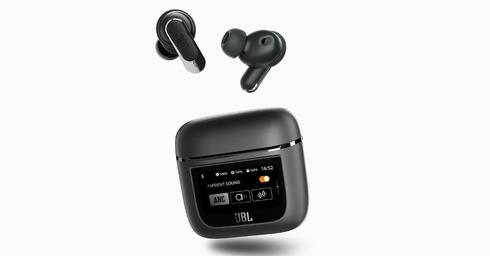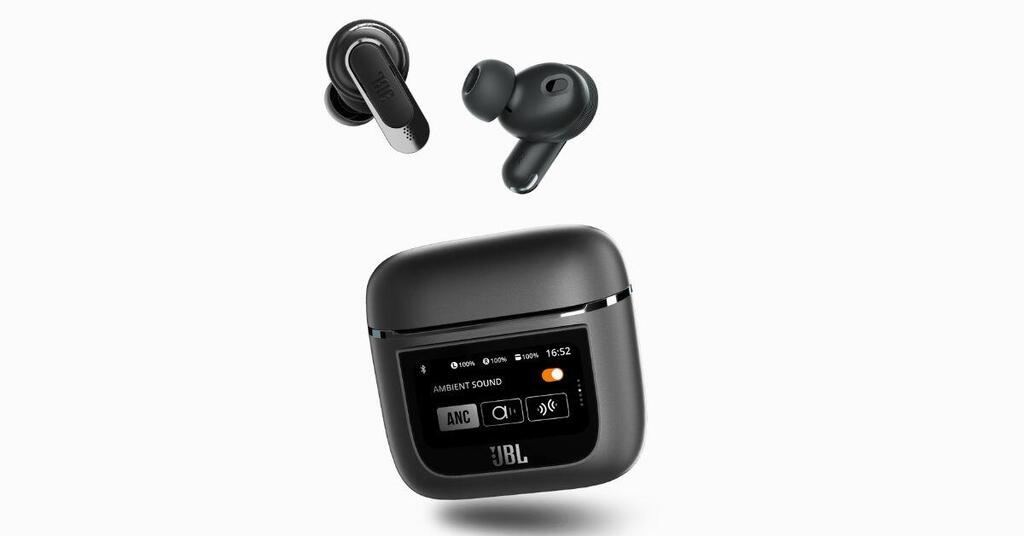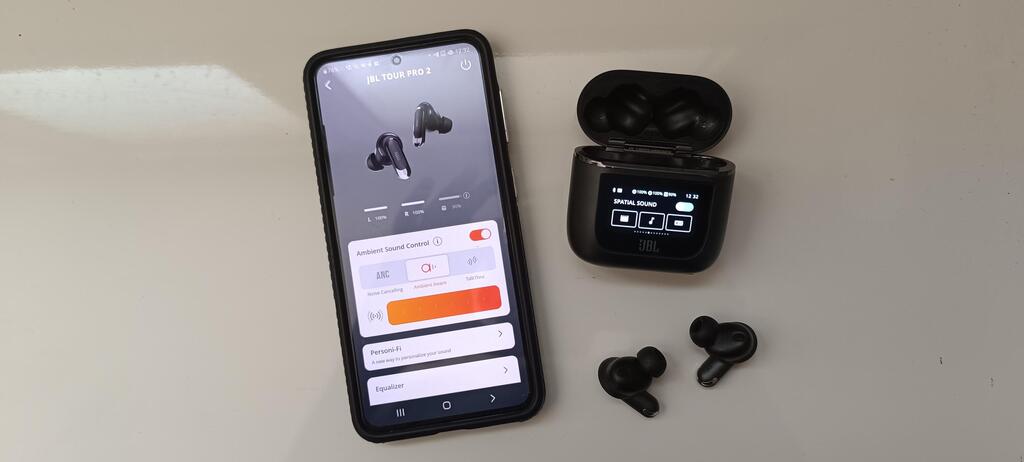
Gadget review
JBL Tour Pro 2: Innovative, but pricey
What can you do with wireless earbuds? JBL offers a new way to control them - with a touch screen on their charging box. CTech's product critic Itai Smuskowitz explores what else the new product can do and if it is even useful
Top Line
The JBL Pro Tour 2 earbuds are indeed successful. They are lightweight, comfortable in the ear, offer excellent sound quality, and provide a wide range of customization options through the app. However, they may not represent the highest quality available, and navigating through the various options and menus in both the application and the charging box can be confusing at times. JBL also claims to offer spatial audio, but this feature doesn't quite deliver as promised.
The smart charging box is a nice addition and has its uses in some cases, showing potential. However, for now, it may not be considered a must-have feature. The added value it provides is not substantial, and innovation often comes at a price, which you will pay at the checkout when purchasing these earbuds.
Details
Smartphones, smart TVs, and even smart water heater clocks – smart devices have been part of our lives for quite a few years. Over time, more of these devices have emerged. You can simply add a Bluetooth or Wi-Fi connection to an existing product, connect an app, and voila, you have a smart device. In some cases, this upgrade seems necessary, while in others, it's not clear who came up with the idea and why it's beneficial.
So, where do JBL's new earbuds fit into this spectrum? At the beginning of this year, the company introduced the JBL Tour Pro 2 – wireless earbuds featuring the first-ever smart charging box equipped with a touchscreen for earbud control. While JBL may be among the first to launch such a product, they're not alone – Apple applied for a patent over a year and a half ago to integrate a touchscreen into the charging case of the AirPods.
Now that the JBL earbuds have hit the shelves, they provide a glimpse of what other competitors are likely considering. It also raises the important question: Is this innovation even necessary?
The earbuds are compact, the box is heavy
JBL's earbuds keep the design of the company's relatively expensive models, with a short stick that sticks out of the ear. They are light and comfortable, and you can leave them in your ears for a long time without them irritating you too much.
They don't have buttons but touch surfaces through which you can control them at a basic level - the default is that through the right earpiece you can play songs, stop them and switch between them and with the left earpiece you can switch between noise isolation modes.
The charging box did receive new capabilities (including its own Bluetooth connection), but the dimensions are still relatively small. At the bottom there is a USB-C socket for charging, at the back there is a surface for wireless charging of the box itself and at the front is the main event: a 1.45-inch touch screen.
All these come with a price - the box is relatively heavy and weighs 85 grams with the earbuds and a little more than 70 grams without them. It's a bit strange to lend any importance to such a weight, but after using wireless earbuds with a regular box, which weighs 20-30 grams less - the difference is definitely noticeable. In addition, because it is a "smart" box and you can control the earbuds through it, the idea is that you will have to carry it with you.
Before I expand on the screen that should steal the show, a brief reference to the earbuds - the sound is good, even very good, but with all the different capabilities (which I will also get to), most of the time it doesn't feel exceptional.
Another screen instead of an app
So what does the small screen do and why is it good? There is a display of the charge level of the batteries, both of the earbuds and of the box; You can play songs and browse through them, control the volume, change the noise isolation mode, locate the earbuds and more. The screen includes 13 different menus, and through the JBL smartphone app you can skip some.
Some of the menus concern the screen itself - its brightness level, what image is displayed on it when it is locked and you can also turn it into a small and not particularly strong flashlight. In this mode the entire screen is lit in white so it can help, a little, in the dark.
The screen shows only some of the menus that appear in the application on the phone, and some of its capabilities are available directly from the earbuds themselves. Therefore, the clear conclusion is that this is an unnecessary addition. On the other hand, it offers the main features that exist in the application, so if you don't want or can't install another application on your phone, you can make do with it to control the earbuds. And even if you have installed the application, there are situations where it would be more convenient to use a screen that is only intended for earbuds instead of pulling out the phone and opening the application. I mean, there is potential here and it's not a completely unnecessary addition.
All the new capabilities of the box have another meaning - it uses firmware, and it also needs to be updated from time to time. It happened to me once, when I took it out of the package and turned it on for the first time.
Beyond controlling the earbuds, the box is connected via Bluetooth to the phone and displays notifications. You can answer an incoming call through it (the call itself will be conducted on the phone), but in most cases it is definitely an unnecessary addition - as soon as you receive a message on WhatsApp, for example, you will receive an alert, but you cannot see the message itself nor the identity of the sender. It won't spare you a look at your phone.
Through the app on your phone, you can also replace the image that appears on the screen on the box. You can choose between several preloaded photos or choose any other photo that is on the phone.
Through the phone you will get much more control
The app is a different story - comfortable to use and nice to look at, but loaded with tons of customization options. It feels a bit too much and the differences are not always clear, although next to each menu there is an explanation.
You can change the settings of the touch surfaces of the earbuds, so that you control the volume instead of playing the songs, for example, you can customize the sound using a short series of sounds that will be played to you and your reactions to them, choose between canceling external noises (ANC) and a mode in which you will hear your surroundings and be aware of what is happening around you or TalkThru, a mode in which you can talk without taking out the earbuds.
To really feel the cancellation of external noises, you will have to push the earbuds firmly into your ear (there is also a menu that helps in this matter and checks the suitability of the earbuds) and in TalkThru mode the volume drops to an almost imperceptible level. I preferred to just stop the music. The default is that if you take out the earbuds or even just one of them they will stop operating, and yes, this setting can also be changed through the app or the charging box.
You can also use the noise canceling alone, without listening to music or a movie - JBL offers a quiet mode that you can set in advance and then the earbuds will take care of muting the noises around you. The company explains that it can help you on flights, for example, and here too you need to make sure that the earbuds fit well into the ear.
The earbuds also, according to JBL, support "spatial audio," which is an audio format designed to envelop you in sound, creating the sensation that it's coming from all directions around you. The company claims that the source of the music or the movie doesn't matter. However, I had my doubts – in services like Apple Music and Netflix, for instance, there's a labeling system indicating which content is available in spatial audio. But can JBL truly transform a regular song or movie into spatial audio? Unfortunately, my suspicion was confirmed: the feature in the earbuds does enhance the audio, making it more impressive, but it doesn't truly deliver spatial audio.
If you choose to activate the equalizer you will find that it has only five modes, and none of them are pop, rock or classical music. You can create your own profile, but it is not clear why they chose to ignore the most prominent genres.
I felt that it was impossible to be satisfied with the default settings that the earbuds come with - after playing a bit with the noise isolation, the audio improvement menu, activating spatial audio and the equalizer I found the formula in which the sound sounded better to me.
The earbuds are waterproof to the IPX5 standard, which should be enough for rain or sweat, officially the batteries are enough for up to 8 hours of playing with active noise cancellation or 10 hours without it, and in a home test they stood up to continuous playback for more than seven hours. A 15-minute charge should be enough for another 4 hours of playing, and according to the charge meter, during this time the battery was charged to 25%.















